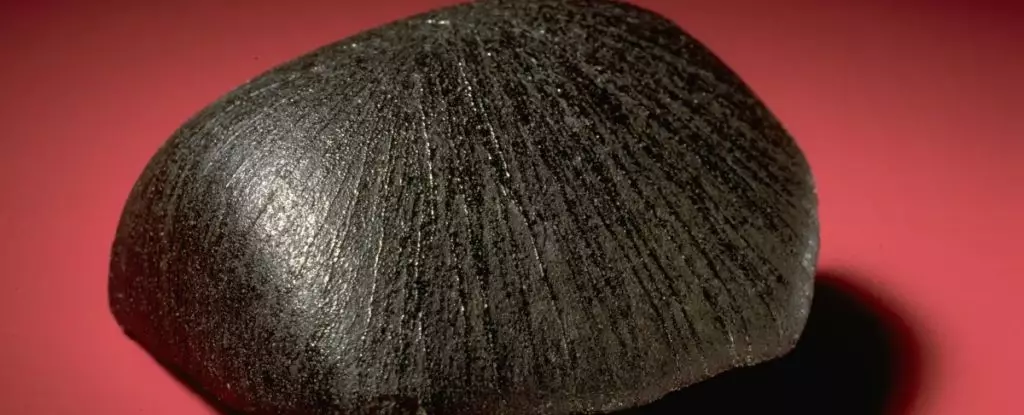The exploration of Mars has captivated scientists and space enthusiasts alike, presenting clues to the planet’s hydrological history. Clear evidence suggests that Mars was not always the desolate, arid landscape it appears to be today. Instead, it was likely teeming with lakes and possibly even oceans. Recent studies on a meteorite known as the Lafayette Meteorite provide critical insights into the timeline of water presence on Mars, shedding light on when liquid water existed on its surface and how it interacts with Martian geology.
The Lafayette Meteorite, which traveled across space for 11 million years before landing on Earth, has revealed significant information about Mars’ wet past. Analysis indicates that certain minerals within the meteorite formed in the presence of liquid water approximately 742 million years ago. This finding, led by geochemist Marissa Tremblay and her colleagues at Purdue University, marks an important breakthrough in understanding the timelines of aqueous minerals on Mars. It paves the way for new methodologies to date alterations in Martian geology further and offers a fresh perspective on how liquid water could have played a role in shaping the planet’s surface.
Far from being an anomaly, the presence of these minerals suggests episodic instances of water on Mars’ surface, rather than a continuous state of being. Tremblay emphasizes that abundant surface water was not likely during this specific period; instead, it is theorized that the liquid water originated from melting subsurface ice, likely caused by volcanic activity beneath Mars’ surface. This suggests that geological processes could still be influencing the availability of water on Mars to this day, allowing for the possibility that the Red Planet could experience bursts of moisture intermittently even now.
Understanding when and how minerals form requires advanced techniques in geochemistry, and the Lafayette Meteorite provided the opportunity to examine such methods. The identification of a rock called iddingsite within the meteorite offers a fascinating clue; this rock is formed from volcanic basalt in the presence of water. By utilizing radiometric dating – specifically focusing on isotopes of argon – researchers could decode the last time water interacted with the mineral composition of the meteorite.
Radiometric dating works through the decay of isotopes; in this case, potassium decays to produce argon. Researchers capitalized on this process by recognizing the relationship between argon-40, argon-39, and potassium to ascertain when the minerals formed. Moreover, the researchers conducted extensive modeling to account for external factors that the meteorite encountered, such as impacts and atmospheric entry, ensuring the accuracy of their findings.
Understanding how these variables could distort the apparent age of minerals is critical to marrying geological anchorage with celestial mechanics, thereby clarifying the evolution of planetary bodies in our solar system.
The timeline established through geological analysis coincides with periods of heightened volcanic activity on Mars. This suggests interconnectedness between volcanic eruptions and potential water presence, resulting from the melting of subterranean ice layers. The importance of volcanoes cannot be overstated; they have been a significant geological force in sculpting not just Mars but terrestrial planets as well.
Interestingly, previous missions, including the Mars InSight lander, have indicated that Mars is still geologically active underneath its surface, challenging perceptions of an inert planet. As it turns out, Mars could be experiencing geology at a level that belies its barren exterior, leading scientists to question what other secrets lie beneath its crust.
The implications of this research extend beyond understanding Mars. The methodologies pioneered in dating aqueous alteration minerals could also lend insight into the history of water on other planetary bodies, including Earth. The ongoing debate regarding the origins of water on our own planet and its relationship with the rest of the solar system is a compelling discussion spurred by findings like those regarding the Lafayette Meteorite.
Tremblay’s team asserts that the techniques they have developed can be applied broadly across various celestial bodies, promoting a deeper understanding of when and where water has been present in the universe. Understanding these cosmic water cycles may reveal how planets evolve, change, and, perhaps, even harbor life.
The nuanced narrative of Mars is gradually unfolding through meticulous scientific inquiry, with the Lafayette Meteorite standing as a testament to the role of ancient water in shaping planetary histories across our solar system. With every discovery, we draw closer to understanding not only the Red Planet’s past but also the mechanisms through which water, a crucial ingredient for life, might exist elsewhere amongst the stars.


Leave a Reply